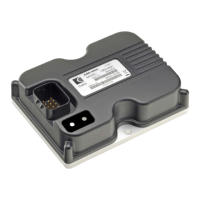Curtis 1352 eXm Manual, R ev. D
9
These are high-power drivers. The internal impedance to ground will cause
leakage current to flow through the output even when the output driver is off.
This leakage current can be enough (>2 mA) to light high-efficiency LEDs.
In the wiring diagram, the output at Pin 11 is shown driving a propor-
tional valve coil. This driver is programmed for Constant Current mode and
would have some Dither applied.
The second output shown (Pin 12) is driving a basic contactor coil. This
output is in the Constant Voltage mode and can be set to run at a lower voltage
than the nominal battery voltage.
Switch Inputs
All the outputs can be used as Active High inputs (“On” when connected to
B+). It is important that the output command be set to 0% for each input used
or a direct short from B+ to B– will be generated when the driver is pulsed On,
which could damage the FET driver. In the wiring diagram, I/O 6 is shown as
an Active High input switching to B+.
Analog Inputs
The first analog input is shown being used with an RTD. This requires enabling
the Analog Input 1 pull-up, which allows the input to measure resistive sensors.
Note that Analog Input 3 can only be used with sensors that provide a voltage
output.
CAN Bus
The eXm has an internal 1kΩ bus termination resistor. This internal impedance
matches the system requirements for a mid-line connection or short stub
connection. If the eXm is to be used at the end of the CAN bus, an external
120Ω ½W resistor must be added externally across the CAN H and CAN L
lines at or near the eXm to provide proper termination. The higher the bit
rate (i.e., the higher the baud), the more critical this becomes. The eXm can
communicate up to 1Mbps on a properly terminated/wired bus.
2 — INSTALLATION & WIRING: Standard Wiring Diagram

